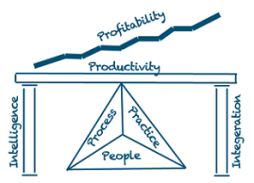10 Advantages Of Agile SDLC
February 9, 2012 1 Comment
Long since software development has come into mainstream it has primarily followed sequential development techniques through the development lifecycle. To be very specific, the SDLC (or software development life cycle) has followed waterfall approach most, where each phase of SDLC is completed before the next stage begins. For example, before any coding begins, the requirements gathering and the architecture design are completed. Though this ‘assembly line’ approach to software development was advantageous in early days of software industry it seems to be getting obsolete for the current generation of software development needs.
In today’s world, traditional SDLC models such as waterfall model, pose a lot of challenges and limitations. It limits the teams from revisiting the stages of SDLC as the traditional approach allows the teams to finish every stage before beginning the next stage. The teams do not revisit the previous stages. The fast paced technological changes in our markets, the increased use of embedded software in devices and the ever increasing uncertainty in the market place makes it impossible for the customers to provide all the requirements at the beginning of the SDLC. By the time the software is estimated to be ready, if developed via waterfall SDLC, it is quite likely that the feature/functional requirements of the software become irrelevant for the customer by the time the software is released.
Agile SDLC evolved out of these experiences in the real-time project development by some of the software development protagonists. Agile methodologies propose to develop software through iterative approach. The entire SDLC is followed in incremental way by dividing the SDLC into cadences of work. At the end of each cadence or iteration the teams deliver a shippable piece of incremental work to the customer. This process leaves enough scope to keep requirements gathering a continuous process and helps the stakeholders determine the course of the software being developed. Unlike the traditional software development approach, in Agile the teams revisit the complete SDLC as a result of providing iterative incremental work that is shippable at the end of every iterative piece.
Together the advantages of Agile SDLC can be listed as under:
- Agile helps to speed up the SDLC phases and bypasses process steps that add little value to the project.
- Usually Agile methodologies promote less formal culture and encourage collaborative team approach.
- Agile facilitates smooth flow of knowledge sharing.
- Engages the stakeholders continuously so that the new requirements are gathered faster and there is no scope for guess work by the teams.
- It incorporates frequent and rapid changes into the SDLC for product functionality and features.
- Saves cost, time and efforts by following iterative incremental work delivery and thereby identifying deviations early.
- Redistributes leadership at various levels within the teams.
- Increases cohesion between the teams to deliver on time.
- Follows crisp and flexible documentation policies which save time.
- Provides the end result of higher quality of the software delivered and a highly satisfied customer.
Looking at all the advantages and the limitations (of the traditional SDLCs) that Agile overcomes for today’s development landscape, it is understood that most of the Web 2.0 e-commerce and web applications are being developed using Agile SDLC. According to an article on PR Web, industry leaders such as Xerox and Microsoft have switched over to Agile methods simply because it saves them cost and also produces better products. If your company is still following traditional models such as Waterfall model, then the inefficiencies in your development processes will be obvious and you may not be able to meet the customers need precisely.
Please share us your thoughts on whether Agile SDLC should be followed by all type of organizations in the industry.



